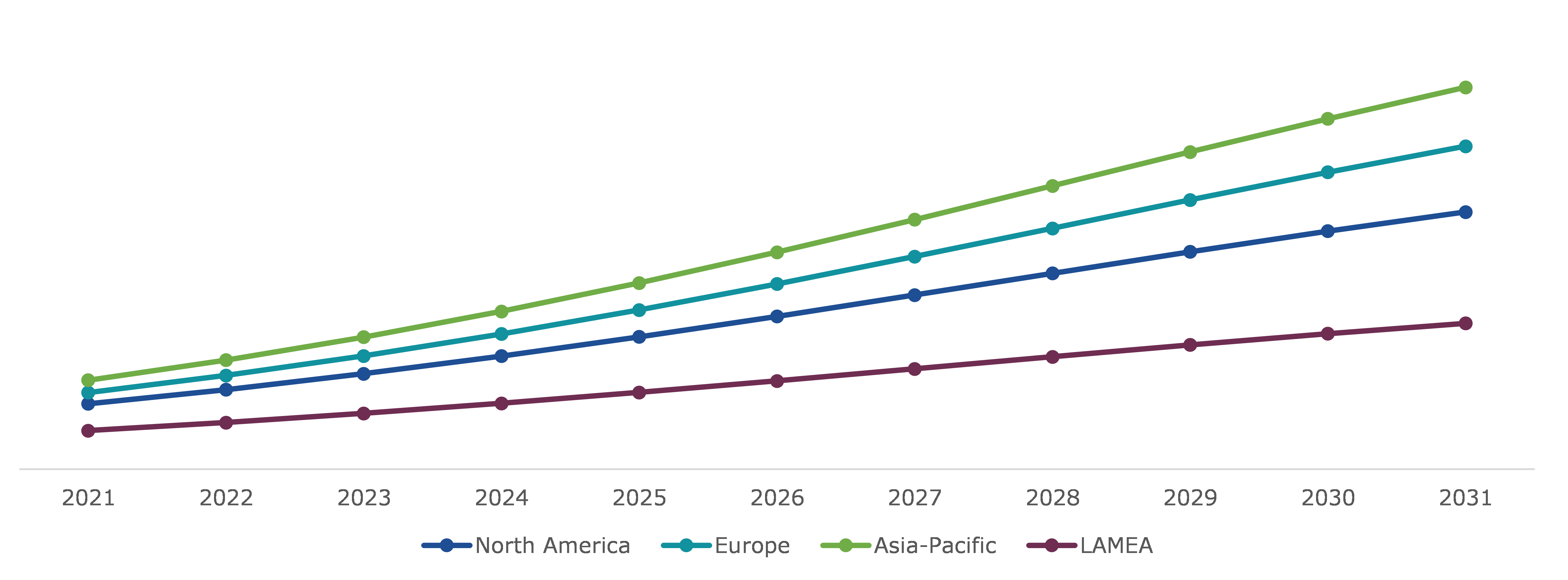Automotive Ethernet Market Report
RA05425
Automotive Ethernet Market by Component (Hardware, Software, and Services), Vehicle Type (Passenger Cars and Commercial Vehicles), Application (Chassis, Infotainment, Driver Assistance, Powertrain, Body and Comfort, and Others), and Regional Analysis (North America, Europe, Asia-Pacific, and LAMEA): Global Opportunity Analysis and Industry Forecast, 2022–2031
Global Automotive Ethernet Market Analysis
The global automotive ethernet market size was valued $2,135.1 million in 2021 and is predicted to grow with a CAGR of 14.4%, by generating a revenue of $8,765.8 million by 2031.
Global Automotive Ethernet Market Synopsis
Automotive ethernet is a physical network that is used to connect various components in a car using a wired network. Automotive manufacturers are increasingly adopting various advanced car functions such as high-powered entertainment systems, seat heating control, advanced airbags, voice input system, Bluetooth integration, automatic mirrors, navigation systems, smartphone connectivity, driver-responsive performance, etc. All of these automotive applications are increasing the bandwidth requirements and making the software used in cars more complicated. Hence, automotive manufacturers are adding more computer-based systems, connections, and applications. However, it is increasing the cost of cabling, network interfaces, etc. Automotive Ethernet deployment will reduce these costs. Several trends show that major car manufacturers are intending to move to Ethernet for all classes of cars in addition to the luxury class.
Automotive ethernet relies heavily on forward error correction (FEC) signal processing techniques to ensure the validity of the data being transmitted. Adding the redundant data bits, however, increases overhead to the link and reduces the effective bandwidth. Moreover, the FEC-based solutions can effectively react to only moderate noise profiles, hence, making them unsuitable for handling instant noises from EMC events.
Earlier there were only limited in-vehicle applications that needed a very low amount of data in few kbps. However, advancements such as driver-assistance systems (ADAS), have led to increasing in the demand for bandwidth. Due to the introduction of ethernet systems in the vehicle-internal networks, the bandwidth can be increased significantly as compared to legacy bus systems. Furthermore, software or configuration updates can be distributed faster. These advantages of automotive ethernet systems are anticipated to have a positive impact on the automotive ethernet market outlook during the forecast period.
Automotive Ethernet Overview
Automotive ethernet is the physical network that is mostly used to link components within the car using a cable. Automotive ethernet offers crucial benefits including the connection between electric vehicles and charging stations, in-vehicle communication, etc. There are numerous communication bus systems in a car such as CAN, FlexRay, LVDS, MOST, etc. Every vehicle component has its dedicated wiring and communication needs. The wiring harness is the 3rd highest-cost element in a car owing to the complex cabling. With the use of automotive ethernet, the cost of automobiles can be reduced greatly as compared to the standard wire harness.
COVID-19 Impact on Automotive Ethernet Market
The COVID-19 pandemic had adversely impacted many businesses with unprecedented challenges around the globe. With the government imposing lockdowns and quarantine mandates many daily activities were halted. These restrictions refrained people from visiting dealership showrooms to buy vehicles, resulting in a steep decline in vehicle sales. The world economy took a hit which has been worse than many earlier economic crises earlier and obstructions in international operations negatively affected the automotive industry, across the globe. This in turn, also affected the global automotive ethernet market growth. However, advancements in the COVID-19 vaccination, government stimulus packages, and the recovery in the global economy have initiated a growth trend in the automotive sector.
Growing Vehicle Demand Worldwide along with Increasing Adoption of Advanced Technologies in the Automotive Industry are Expected to Drive the Automotive Ethernet Market
The massive automotive ethernet market growth is majorly attributed to the increased demand for vehicles across the globe. Ease in supply chain disturbances post-COVID-19 pandemic led numerous vehicle manufacturers to register healthy vehicle production and sales. Presently, consumers are increasingly inclined toward experiencing an advanced in-car experience, hence, there is a tremendous rise in digital transformation in the automotive industry. The addition of innovative solutions such as connected devices, machine learning (ML) and artificial intelligence (AI), connected vehicles, etc. accelerates innovation in the automotive industry and ultimately, increases automotive ethernet market demand. solutions. Companies are highly focusing on intelligent automotive ethernet solutions to design the cutting-edge, high-bandwidth communications systems required by next-generation vehicles.
Increasing Number of Potential Attackers May Restrain the Automotive Ethernet Market Growth
The number of potential attackers on ethernet systems is higher compared to other automotive bus technologies. Yet there are no standardized techniques for automotive ethernet networks to limit access to untrusted devices. The misuse of devices such as modifications of software parts and the replacement of components with third-party devices can direct undefined behavior and impact the security of the vehicle. Thus, it is crucial to ensure consistency of the automotive ethernet network by controlling access to unknown network participants, misbehavior of existent devices, as well as any spoofing attempts.
Growing Emphasis on the Reduction of Carbon Footprint to Create Investment Opportunities
Carbon emission is one of the major concerns these days due to global warming and CO2 is one of the major contributors to global warming. The vehicular emissions greatly lead to CO2 emissions. For instance, according to research conducted by U.S. Environmental Protection Agency, in 2019, greenhouse gas emissions from the transportation sector accounted for around 29% of total U.S. greenhouse gas emissions. Therefore, the adoption of ‘two low-power’ versions of automobile ethernet is expected to significantly increase, which mainly helps in the reduction of CO2 emissions. Also, several companies like Microchip Technology Inc., a leading provider of mixed-signal, Flash-IP solutions, and microcontroller, are developing novel technological innovations as a strategy to grow in the market. These strategies are estimated to increase investments and fuel the automotive ethernet market opportunity in the upcoming years.
Global Automotive Ethernet Market Share, by Component
Based on component, the market has been divided into hardware, software, and services. Among these, the hardware sub-segment held the largest market share in 2021 whereas the services sub-segment is anticipated to experience the fastest growth during the forecast period.
Global Automotive Ethernet Market Size, by Component, 2021
Source: Research Dive Analysis
The hardware sub-segment of automotive ethernet industry held the largest market share in the global automotive ethernet market during the forecast period. There are broad range of major benefits of automotive ethernet such as scalability which is increased transaction speed without sacrificing security. The exponential increase in the demand for infotainment and advanced driver-assistance system (ADAS) has encouraged the automotive original equipment manufacturers (OEMs) to use ethernet hardware components such as gateway, repeaters, and bridges routers. Also, key companies like NXP Semiconductors are coming up with product innovations, which are further creating a significant impact on the global automotive ethernet market share. Such product advancements are anticipated to drive the automotive ethernet market trend in the upcoming years.
The services sub-segment of the global automotive ethernet industry is expected to grow with the highest CAGR during the forecast period. The services sub-segment generally involves training & support and consulting. The highly expanding demand for consulting services at the original equipment manufacturers (OEMs) to manage the in-vehicle network complexity is one of the important aspects fueling the growth of the services sub-segment. Moreover, the growing instances of troubles experienced during the adoption of ethernet systems in cars may further boost the necessity for services sub-segment in the upcoming years.
Global Automotive Ethernet Market Value, by Application
Based on application, the market has been divided into chassis, infotainment, driver assistance, powertrain, body and comfort, and others. Among these, the driver assistance sub-segment is expected to have the largest market share and the fastest growth during the forecast period.
lobal Automotive Ethernet Market Forecast, by Application, 2021
Source: Research Dive Analysis
The driver assistance sub-segment of the global automotive ethernet market is projected to have the fastest growth during the forecast period. Driver assistance applications include systems developed to assist the driver in the driving process and increase safety for the driver, passengers, and pedestrians. Advanced driver assistance systems and V2X connectivity are the two major elements of autonomous vehicles. The more sophisticated the system is, the more will be complexity required to handle electrical and electronic systems. These advanced systems produce, process, and consume large volumes of data in real time. To process this huge volume of data in real-time with a very low level of latency, a reliable, high-speed network is required and Automotive Ethernet is the right choice for this purpose.
Global Automotive Ethernet Market Trends, by Vehicle Type
Based on vehicle type, the market has been divided into passenger cars and commercial vehicles. Among these, the commercial vehicles sub-segment is predicted to have the fastest growth and passenger cars sub-segment is anticipated to garner the maximum automotive ethernet market share in the global market.
Global Automotive Ethernet Market Growth, by Vehicle Type, 2021
Source: Research Dive Analysis
The commercial vehicle sub-segment of the global automotive ethernet market is predicted to have a most rapid growth during the forecast period. A commercial vehicle is any type of motor vehicle which is used for transporting goods or paying passengers. Increasing infrastructural investments and digitization is estimated to contribute to the growth of the commercial vehicle segment in the upcoming years. Many key players like Molex, a technology leader in data communications and commercial vehicles are strategizing collaborations to grow in the market. For instance, in January 2018, Molex and Aquantia, a leading player in high-speed transceivers, announced a strategic tie-up. As per this agreement, both companies will work on leveraging ‘Aquantia Multi-Gig Automotive Ethernet’ technologies in the Molex 10 Gbps automotive ethernet network in order to escalate data bandwidth in autonomous and connected vehicles. Such advanced strategies may bolster the sub-segment growth, in the projected period.
The passenger cars sub-segment is predicted to have a dominating market share in the global market during the analysis timeframe. The rise in economic conditions and technological advancements in passenger cars is propelling extensive growth in the passenger cars sub-segment of the automotive ethernet industry. Also, automotive ethernet provides numerous key features such as low cost, higher bandwidth, that are suitable for both multiple car series. These factors are major drivers to boost the growth of passenger cars sub-segment during the projected timeframe.
Global Automotive Ethernet Market Size, Regional Insights
The automotive ethernet market was investigated across North America, Europe, Asia-Pacific, and LAMEA.
Global Automotive Ethernet Market Size & Forecast, by region, 2021-2031 (USD Million)
Source: Research Dive Analysis
The Market for Automotive Ethernet in Asia-Pacific is the Most Dominant and Fastest Growing
The Asia-Pacific automotive ethernet market is expected to register the highest revenue during the forecast period. The Asia-Pacific automotive ethernet market is registering exponential growth due to growth in the automotive sector. The automotive sector has witnessed notable transformation owing to technological innovations and stable socio-political conditions. Asia-Pacific region is contributing the largest share in terms of manufacturing of vehicles as well as sales of vehicles globally. Furthermore, the mass consumer base and surging disposable income across the emerging countries in this region are fueling the automotive industry, and ultimately, the automotive ethernet industry.
Competitive Scenario in the Global Automotive Ethernet Market
Product launches and mergers & acquisitions are common strategies followed by major market players. For instance, in March 2019, Broadcom launched BCM8956X, a family of automotive multilayer ethernet switches. This product will help the company address the growing need for bandwidth, security, and time-sensitive networking (TSN). The product is IEEE compliant for 100 BASE-T1 PHY. Broadcom would help automotive OEMs and leading suppliers to enter into the Gigabit Ethernet Systems.
Source: Research Dive Analysis
Some of the leading automotive ethernet market players are Vector Informatik GmbH, NXP Semiconductors, Marvell, Molex, Broadcom, Microchip Technology Inc., Aukua Systems Inc., Keysight Technologies, Cadence Design Systems, Inc, and Texas Instruments Incorporated.
| Aspect | Particulars |
| Historical Market Estimations | 2019-2020 |
| Base Year for Market Estimation | 2021 |
| Forecast Timeline for Market Projection | 2022-2031 |
| Geographical Scope | North America, Europe, Asia-Pacific, and LAMEA |
| Segmentation by Component |
|
| Segmentation by Application |
|
| Segmentation by Vehicle Type |
|
| Key Companies Profiled |
|
Q1. What is the size of the global automotive ethernet market?
A. The size of the global automotive ethernet market was $ 2,135.1 million in 2021 and is projected to reach $ 8,765.8 million by 2031.
Q2. Which are the major companies in the automotive ethernet market?
A. Vector Informatik GmbH, NXP Semiconductors N.V., and Marvell Semiconductor, Inc., are some of the key players in the global automotive ethernet market.
Q3. Which region, among others, possesses greater investment opportunities in the near future?
A. The Asia-Pacific region possesses great investment opportunities for investors to witness the most promising growth in the future.
Q4. What will be the growth rate of the Asia-Pacific automotive ethernet market?
A. Asia Pacific automotive ethernet market is anticipated to grow at 14.9% CAGR during the forecast period.
Q5. What are the strategies opted by the leading players in this market?
A. Technological development and strategic partnerships are the key strategies opted by the operating companies in this market.
Q6. Which companies are investing more on R&D practices?
A. Molex, Broadcom Inc. are investing more on R&D activities for developing new products and technologies.
1.Research Methodology
1.1.Desk Research
1.2.Real time insights and validation
1.3.Forecast model
1.4.Assumptions and forecast parameters
1.5.Market size estimation
1.5.1.Top-down approach
1.5.2.Bottom-up approach
2.Report Scope
2.1.Market definition
2.2.Key objectives of the study
2.3.Report overview
2.4.Market segmentation
2.5.Overview of the impact of COVID-19 on Global Automotive Ethernet Market
3.Executive Summary
4.Market Overview
4.1.Introduction
4.2.Growth impact forces
4.2.1.Drivers
4.2.2.Restraints
4.2.3.Opportunities
4.3.Market value chain analysis
4.3.1.List of raw material suppliers
4.3.2.List of manufacturers
4.3.3.List of distributors
4.4.Innovation & sustainability matrices
4.4.1.Technology matrix
4.4.2.Regulatory matrix
4.5.Porter’s five forces analysis
4.5.1.Bargaining power of suppliers
4.5.2.Bargaining power of consumers
4.5.3.Threat of substitutes
4.5.4.Threat of new entrants
4.5.5.Competitive rivalry intensity
4.6.PESTLE analysis
4.6.1.Political
4.6.2.Economical
4.6.3.Social
4.6.4.Technological
4.6.5.Environmental
4.7.Impact of COVID-19 on Automotive Ethernet Market
4.7.1.Pre-covid market scenario
4.7.2.Post-covid market scenario
5.Automotive Ethernet Market Analysis, by Component
5.1.Overview
5.2.Hardware
5.2.1.Definition, key trends, growth factors, and opportunities, 2022-2031
5.2.2.Market size analysis, by region, 2022-2031
5.2.3.Market share analysis, by country, 2022-2031
5.3.Software
5.3.1.Definition, key trends, growth factors, and opportunities, 2022-2031
5.3.2.Market size analysis, by region, 2022-2031
5.3.3.Market share analysis, by country, 2022-2031
5.4.Services
5.4.1.Definition, key trends, growth factors, and opportunities, 2022-2031
5.4.2.Market size analysis, by region, 2022-2031
5.4.3.Market share analysis, by country, 2022-2031
5.5.Research Dive Exclusive Insights
5.5.1.Market attractiveness, 2022-2031
5.5.2.Competition heatmap, 2022-2031
6.Automotive Ethernet Market Analysis, by Application
6.1.Chassis
6.1.1.Definition, key trends, growth factors, and opportunities, 2022-2031
6.1.2.Market size analysis, by region, 2022-2031
6.1.3.Market share analysis, by country, 2022-2031
6.2.Infotainment
6.2.1.Definition, key trends, growth factors, and opportunities, 2022-2031
6.2.2.Market size analysis, by region, 2022-2031
6.2.3.Market share analysis, by country, 2022-2031
6.3. Driver Assistance
6.3.1.Definition, key trends, growth factors, and opportunities, 2022-2031
6.3.2.Market size analysis, by region, 2022-2031
6.3.3.Market share analysis, by country, 2022-2031
6.4.Power train
6.4.1.Definition, key trends, growth factors, and opportunities, 2022-2031
6.4.2.Market size analysis, by region, 2022-2031
6.4.3.Market share analysis, by country, 2022-2031
6.5. Body and Comfort
6.5.1.Definition, key trends, growth factors, and opportunities, 2022-2031
6.5.2.Market size analysis, by region, 2022-2031
6.5.3.Market share analysis, by country, 2022-2031
6.6.Others
6.6.1.Definition, key trends, growth factors, and opportunities, 2022-2031
6.6.2.Market size analysis, by region, 2022-2031
6.6.3.Market share analysis, by country, 2022-2031
6.7.Research Dive Exclusive Insights
6.7.1.Market attractiveness, 2022-2031
6.7.2.Competition heatmap, 2022-2031
7.Automotive Ethernet Market Analysis, by Vehicle Type
7.1.Passenger Cars
7.1.1.Definition, key trends, growth factors, and opportunities, 2022-2031
7.1.2.Market size analysis, by region, 2022-2031
7.1.3.Market share analysis, by country, 2022-2031
7.2.Commercial Vehicle Types
7.2.1.Definition, key trends, growth factors, and opportunities, 2022-2031
7.2.2.Market size analysis, by region, 2022-2031
7.2.3.Market share analysis, by country, 2022-2031
7.3.Research Dive Exclusive Insights
7.3.1.Market attractiveness, 2022-2031
7.3.2.Competition heatmap, 2022-2031
8.Automotive Ethernet Market, by Region
8.1.North America
8.1.1.U.S.
8.1.1.1.Market size analysis, by Component, 2022-2031
8.1.1.2.Market size analysis, by Vehicle Type, 2022-2031
8.1.1.3.Market size analysis, by Application, 2022-2031
8.1.2.Canada
8.1.2.1.Market size analysis, by Component, 2022-2031
8.1.2.2.Market size analysis, by Vehicle Type, 2022-2031
8.1.2.3.Market size analysis, by Application, 2022-2031
8.1.3.Mexico
8.1.3.1.Market size analysis, by Component, 2022-2031
8.1.3.2.Market size analysis, by Vehicle Type, 2022-2031
8.1.3.3.Market size analysis, by Application, 2022-2031
8.1.4.Research Dive Exclusive Insights
8.1.4.1.Market attractiveness, 2022-2031
8.1.4.2.Competition heatmap, 2022-2031
8.2.Europe
8.2.1.Germany
8.2.1.1.Market size analysis, by Component, 2022-2031
8.2.1.2.Market size analysis, by Vehicle Type, 2022-2031
8.2.1.3.Market size analysis, by Application, 2022-2031
8.2.2.UK
8.2.2.1.Market size analysis, by Component, 2022-2031
8.2.2.2.Market size analysis, by Vehicle Type, 2022-2031
8.2.2.3.Market size analysis, by Application, 2022-2031
8.2.3.France
8.2.3.1.Market size analysis, by Component, 2022-2031
8.2.3.2.Market size analysis, by Vehicle Type, 2022-2031
8.2.3.3.Market size analysis, by Application, 2022-2031
8.2.4.Spain
8.2.4.1.Market size analysis, by Component, 2022-2031
8.2.4.2.Market size analysis, by Vehicle Type, 2022-2031
8.2.4.3.Market size analysis, by Application, 2022-2031
8.2.5.Italy
8.2.5.1.Market size analysis, by Component, 2022-2031
8.2.5.2.Market size analysis, by Vehicle Type, 2022-2031
8.2.5.3.Market size analysis, by Application, 2022-2031
8.2.6.Rest of Europe
8.2.6.1.Market size analysis, by Component, 2022-2031
8.2.6.2.Market size analysis, by Vehicle Type, 2022-2031
8.2.6.3.Market size analysis, by Application, 2022-2031
8.2.7.Research Dive Exclusive Insights
8.2.7.1.Market attractiveness, 2022-2031
8.2.7.2.Competition heatmap, 2022-2031
8.3.Asia Pacific
8.3.1.China
8.3.1.1.Market size analysis, by Component, 2022-2031
8.3.1.2.Market size analysis, by Vehicle Type, 2022-2031
8.3.1.3.Market size analysis, by Application, 2022-2031
8.3.2.Japan
8.3.2.1.Market size analysis, by Component, 2022-2031
8.3.2.2.Market size analysis, by Vehicle Type, 2022-2031
8.3.2.3.Market size analysis, by Application, 2022-2031
8.3.3.India
8.3.3.1.Market size analysis, by Component, 2022-2031
8.3.3.2.Market size analysis, by Vehicle Type, 2022-2031
8.3.3.3.Market size analysis, by Application, 2022-2031
8.3.4.Australia
8.3.4.1.Market size analysis, by Component, 2022-2031
8.3.4.2.Market size analysis, by Vehicle Type, 2022-2031
8.3.4.3.Market size analysis, by Application, 2022-2031
8.3.5.South Korea
8.3.5.1.Market size analysis, by Component, 2022-2031
8.3.5.2.Market size analysis, by Vehicle Type, 2022-2031
8.3.5.3.Market size analysis, by Application, 2022-2031
8.3.6.Rest of Asia Pacific
8.3.6.1.Market size analysis, by Component, 2022-2031
8.3.6.2.Market size analysis, by Vehicle Type, 2022-2031
8.3.6.3.Market size analysis, by Application, 2022-2031
8.3.7.Research Dive Exclusive Insights
8.3.7.1.Market attractiveness, 2022-2031
8.3.7.2.Competition heatmap, 2022-2031
8.4.LAMEA
8.4.1.Brazil
8.4.1.1.Market size analysis, by Component, 2022-2031
8.4.1.2.Market size analysis, by Vehicle Type, 2022-2031
8.4.1.3.Market size analysis, by Application, 2022-2031
8.4.2.Saudi Arabia
8.4.2.1.Market size analysis, by Component, 2022-2031
8.4.2.2.Market size analysis, by Vehicle Type, 2022-2031
8.4.2.3.Market size analysis, by Application, 2022-2031
8.4.3.UAE
8.4.3.1.Market size analysis, by Component, 2022-2031
8.4.3.2.Market size analysis, by Vehicle Type, 2022-2031
8.4.3.3.Market size analysis, by Application, 2022-2031
8.4.4.South Africa
8.4.4.1.Market size analysis, by Component, 2022-2031
8.4.4.2.Market size analysis, by Vehicle Type, 2022-2031
8.4.4.3.Market size analysis, by Application, 2022-2031
8.4.5.Rest of LAMEA
8.4.5.1.Market size analysis, by Component, 2022-2031
8.4.5.2.Market size analysis, by Vehicle Type, 2022-2031
8.4.5.3.Market size analysis, by Application, 2022-2031
8.4.6.Research Dive Exclusive Insights
8.4.6.1.Market attractiveness, 2022-2031
8.4.6.2.Competition heatmap, 2022-2031
9.Competitive Landscape
9.1.Top winning strategies, 2022
9.1.1.By strategy
9.1.2.By year
9.2.Strategic overview
9.3.Market share analysis, 2022
10.Company Profiles
10.1. Vector Informatik GmbH
10.1.1.Overview
10.1.2.Business segments
10.1.3.Product portfolio
10.1.4.Financial performance
10.1.5.Recent developments
10.1.6.SWOT analysis
10.2.NXP Semiconductors
10.2.1.Overview
10.2.2.Business segments
10.2.3.Product portfolio
10.2.4.Financial performance
10.2.5.Recent developments
10.2.6.SWOT analysis
10.3.Marvell
10.3.1.Overview
10.3.2.Business segments
10.3.3.Product portfolio
10.3.4.Financial performance
10.3.5.Recent developments
10.3.6.SWOT analysis
10.4. Molex
10.4.1.Overview
10.4.2.Business segments
10.4.3.Product portfolio
10.4.4.Financial performance
10.4.5.Recent developments
10.4.6.SWOT analysis
10.5.Broadcom
10.5.1.Overview
10.5.2.Business segments
10.5.3.Product portfolio
10.5.4.Financial performance
10.5.5.Recent developments
10.5.6.SWOT analysis
10.6.Microchip Technology Inc.
10.6.1.Overview
10.6.2.Business segments
10.6.3.Product portfolio
10.6.4.Financial performance
10.6.5.Recent developments
10.6.6.SWOT analysis
10.7.Aukua Systems Inc.
10.7.1.Overview
10.7.2.Business segments
10.7.3.Product portfolio
10.7.4.Financial performance
10.7.5.Recent developments
10.7.6.SWOT analysis
10.8.Keysight Technologies
10.8.1.Overview
10.8.2.Business segments
10.8.3.Product portfolio
10.8.4.Financial performance
10.8.5.Recent developments
10.8.6.SWOT analysis
10.9.Cadence Design Systems, Inc.
10.9.1.Overview
10.9.2.Business segments
10.9.3.Product portfolio
10.9.4.Financial performance
10.9.5.Recent developments
10.9.6.SWOT analysis
10.10.Texas Instruments Incorporated.
10.10.1.Overview
10.10.2.Business segments
10.10.3.Product portfolio
10.10.4.Financial performance
10.10.5.Recent developments
10.10.6.SWOT analysis
11.Appendix
11.1.Parent & peer market analysis
11.2.Premium insights from industry experts
11.3.Related reports
There have been spectacular developments in the automotive sector in the last few years. The complexity of electrical and electronic modules is increasing in new-age automobiles. Automobile manufacturers are constantly working on advancing the high-end vehicular functions to offer a smooth driving experience. The integration of automotive ethernet in vehicles is one of the substantial advancements the automotive industry has perceived in the recent years. Automotive Ethernet is a super-quick in-vehicle communication technology that offers very high bandwidth, which is highly required for to support high-end vehicular functions.
In high-tech autonomous and connected cars, it is essential that all the technologies have proper communication within the automotive infrastructure. The implementation of automotive ethernet can facilitate high bandwidth of data in real-time and enable smooth functioning of the in-vehicle systems. These days, the demand for automotive ethernet in vehicles has surged tremendously, which is driving the revenues of the global automotive ethernet market.
Newest Insights in the Automotive Ethernet Market
The growing integration of digital technologies and high-end features in vehicles by automakers is augmenting the global automotive ethernet market. As per a report by Research Dive, the global automotive ethernet market is expected to surpass $8,765.8 million by 2031 and grow with a remarkable CAGR of 14.4% in the 2022–2031 timeframe. The Asia-Pacific automotive ethernet market is expected to perceive dominant and fastest growth in the coming years. This is because of the gigantic demand for automotive ethernet in vehicles, rising disposable income of people, and increasing demand for high-tech features in cars in the region. Moreover, the rising adoption of autonomous vehicles in this region is also accountable for the growth of the market.
How are the Market Players Responding to the Growing Demand for Automotive Ethernets?
Market players are significantly executing revolutionary business strategies and investing in novel developments to fulfil the rising demand for automotive ethernet. Some of the leading players in the automotive ethernet market are Vector Informatik GmbH, Microchip Technology Inc., NXP Semiconductors, Broadcom, Aukua Systems Inc., Marvell, Keysight Technologies, Cadence Design Systems, Inc, Texas Instruments Incorporated., Molex, and others. These players are focused on planning and devising tactics such as mergers and novel advances, acquisitions, collaborations, and partnerships to attain a robust position in the global market.
For instance,
- In November 2021, Elektrobit, an automotive software company, launched an industry-leading Automotive Ethernet Switch Firmware for enabling high-performance, secure, in-vehicle communications.
- In December 2021, Marvell, a leading provider of data infrastructure technology, launched the 88QB5224, an industry-first multi-gig Ethernet camera bridge solution for top-class video distribution in connected vehicles.
- In May 2022, Broadcom Inc., an American designer, manufacturer, and supplier of a huge range of semiconductor and infrastructure software products, announced that it has offered its BCM8958X, a high bandwidth monolithic automotive Ethernet switch device, which is specifically designed to fulfil the growing need for the bandwidth for in-vehicle networking applications and boost the adoption of software defined vehicles (SDV).
COVID-19 Impact on the Global Automotive Ethernet Market
The outbreak of the coronavirus pandemic in 2020 has adversely impacted the global automotive ethernet market. The demand for automobiles declined significantly during the pandemic owing to travel restrictions and economic collapse in several countries. Moreover, a sudden slowdown in the operations of the automotive industry owing to lockdown restrictions delayed the manufacturing of automotive ethernet during the pandemic. All these factors extensively deterred the market growth during the pandemic period. However, as the pandemic is relaxing since the end of 2021, the market is expected to witness a massive growth in the upcoming years owing to the increasing advancements by market players in automotive ethernet technologies.
Personalize this research
- Triangulate with your own data
- Request your format and definition
- Get a deeper dive on a specific application, geography, customer or competitor
- + 1-888-961-4454 Toll - Free
- support@researchdive.com







